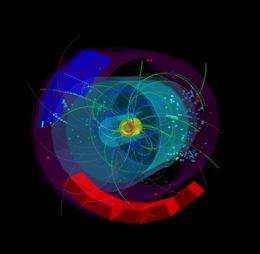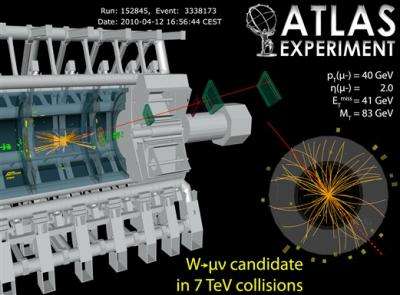Conference highlights first results from the Large Hadron Collider

First results from the LHC at CERN are being revealed at ICHEP, the world's largest international conference on particle physics, which has attracted more than 1000 participants to its venue in Paris. The spokespersons of the four major experiments at the Large Hadron Collider (LHC) - ALICE, ATLAS, CMS and LHCb - are today presenting measurements from the first three months of successful LHC operation at 3.5 TeV per beam, an energy three and a half times higher than previously achieved at a particle accelerator.
With these first measurements the experiments are rediscovering the particles that lie at the heart of the Standard Model - the package that contains current understanding of the particles of matter and the forces that act between them. This is an essential step before moving on to make discoveries. Among the billions of collisions already recorded are some that contain 'candidates' for the top quark, for the first time at a European laboratory.
"Rediscovering our 'old friends' in the particle world shows that the LHC experiments are well prepared to enter new territory" said CERN's Director-General Rolf Heuer. "It seems that the Standard Model is working as expected. Now it is down to nature to show us what is new."
The quality of the results presented at ICHEP bears witness both to the excellent performance of the LHC and to the high quality of the data in the experiments. The Large Hadron Collider, which is still in its early days, is making steady progress towards its ultimate operating conditions. The luminosity - a measure of the collision rate - has already risen by a factor of more than a thousand since the end of March. This rapid progress with commissioning the LHC beam has been matched by the speed with which the data on billions of collisions have been processed by the Worldwide LHC Computing Grid, which allows data from the experiments to be analysed at collaborating centres around the world.
"Within days we were finding Ws, and later Zs - the two carriers of the weak force discovered here at CERN nearly 30 years ago," said Fabiola Gianotti, spokesperson for the 3000-strong ATLAS collaboration. "Thanks to the efforts of the whole collaboration, in particular the young scientists, everything from data-taking at the detector, through calibration, data processing and distribution, to the physics analysis, has worked fast and efficiently."

"It is amazing to see how quickly we have 're-discovered' the known particles: from the lightest resonances up to the massive top quark. What we have shown here in Paris is just the first outcome of an intense campaign of accurate measurements of their properties." said Guido Tonelli, spokesperson for CMS. "This patient and systematic work is needed to establish the known background to any new signal."
"The LHCb experiment is tailor-made to study the family of b particles, containing beauty quarks," said the experiment's spokesperson Andrei Golutvin, "So it's extremely gratifying that we are already finding hundreds of examples of these particles, clearly pin-pointed through the analysis of many particle tracks."
"The current running with proton collisions has allowed us to connect with results from other experiments at lower energies, test and improve the extrapolations made for the LHC, and prepare the ground for the heavy-ion runs," said Jurgen Schukraft, spokesperson for the ALICE collaboration. This experiment is optimized to study collisions of lead ions, which will occur in the LHC for the first time later this year.
Two further experiments have also already benefited from the first months of LHC operation at 3.5 TeV per beam. LHCf, which is studying the production of neutral particles in proton-proton collisions to help in understanding cosmic-ray interactions in the Earth's atmosphere, has already collected the data it needs at a beam energy of 3.5 TeV. TOTEM, which has to move close to the beams for its in-depth studies of the proton, is beginning to make its first measurements.
CERN will run the LHC for 18-24 months with the objective of delivering enough data to the experiments to make significant advances across a wide range of physics processes. With the amount of data expected, referred to as one inverse femtobarn, the experiments should be well placed to make inroads in to new territory, with the possibility of significant discoveries.
More information: www.ichep2010.fr/
Provided by CERN





















